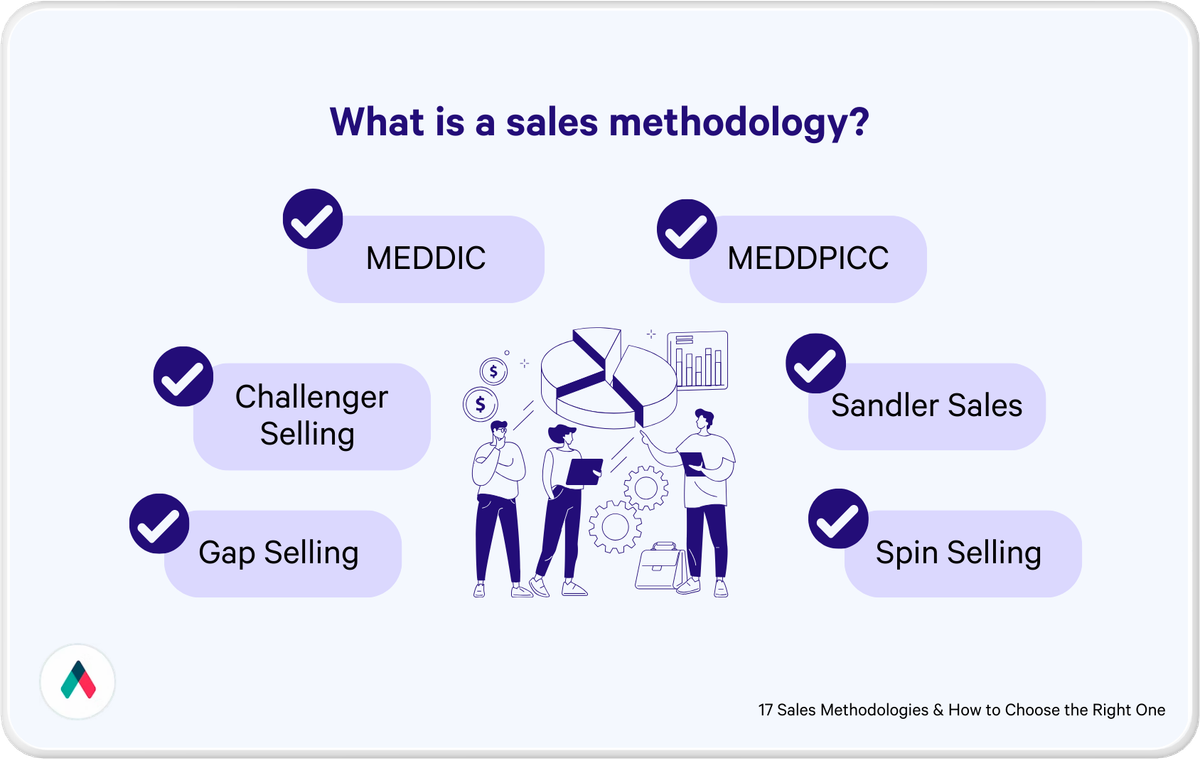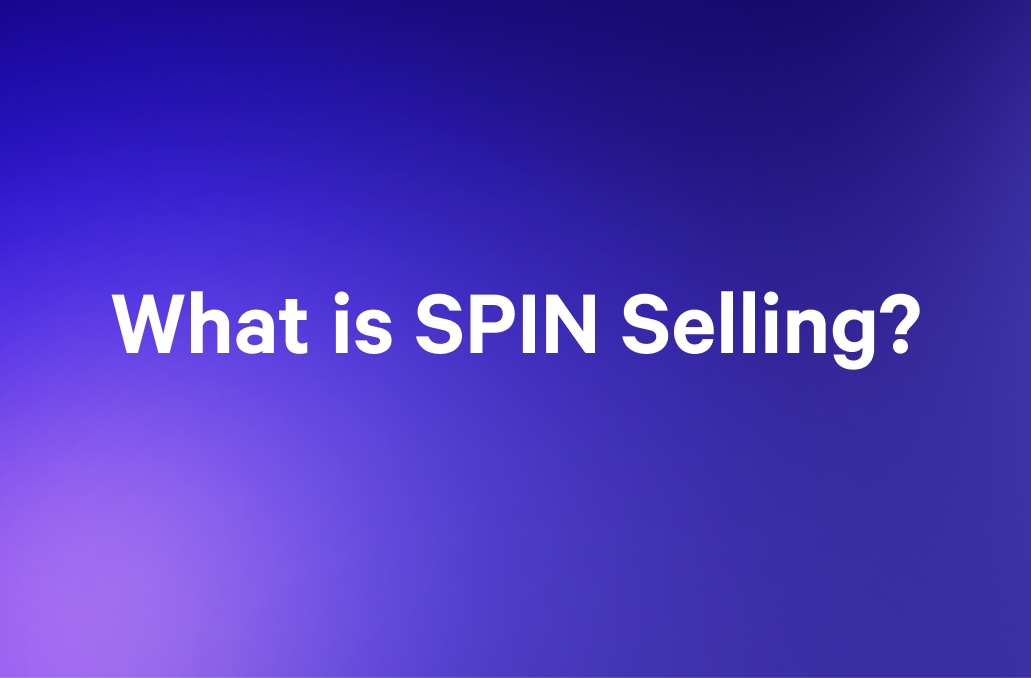Sales reps selling to large companies—whether enterprise software like Salesforce or SAP, manufacturing equipment, or professional services—often hear from their managers that they need to be "more strategic." But without clear examples or specific steps, this advice is difficult to put into practice during actual deals involving multiple decision-makers.
Sales leaders face a similar challenge: how to coach their teams beyond general advice like "build relationships" or "understand their needs." What specific tools or methods help sales reps sell strategically and consistently across the entire team?
The answer came four decades ago when Robert B. Miller and Stephen E. Heiman published "Strategic Selling" in 1985. In this article, we'll break down the Miller Heiman sales process and guide their approach throughout extended enterprise deals.
What is the Miller Heiman sales process?
The Miller Heiman sales process is a strategic selling framework published in 1985 that helps B2B sales teams navigate complex sales with multiple stakeholders.
It uses tools like the Blue Sheet to map buying influences, identify win-win outcomes, and build long-term customer relationships. A Blue Sheet is Miller Heiman's strategic analysis tool that maps your single sales objective, buying influences and their degrees of influence, strengths and red flags, ideal customer criteria, and action plan—all in one living document that updates throughout the sales cycle.
While this sales methodology may be a bit dated, it still works well in a modern sales environment.
What makes the Miller Heiman sales process unique?
The Miller Heiman methodology focuses on mapping all decision-makers and influencers before the first sales call, rather than building relationships organically as opportunities develop.
Unlike SPIN Selling (Neil Rackham, 1988) or Challenger Sale (Matthew Dixon, 2011), which teach specific conversation frameworks for SaaS sales strategy, Miller Heiman requires sales teams to identify and document every stakeholder—Economic Buyers, User Buyers, Technical Buyers, and Coaches—in the Blue Sheet analysis tool during initial deal qualification.
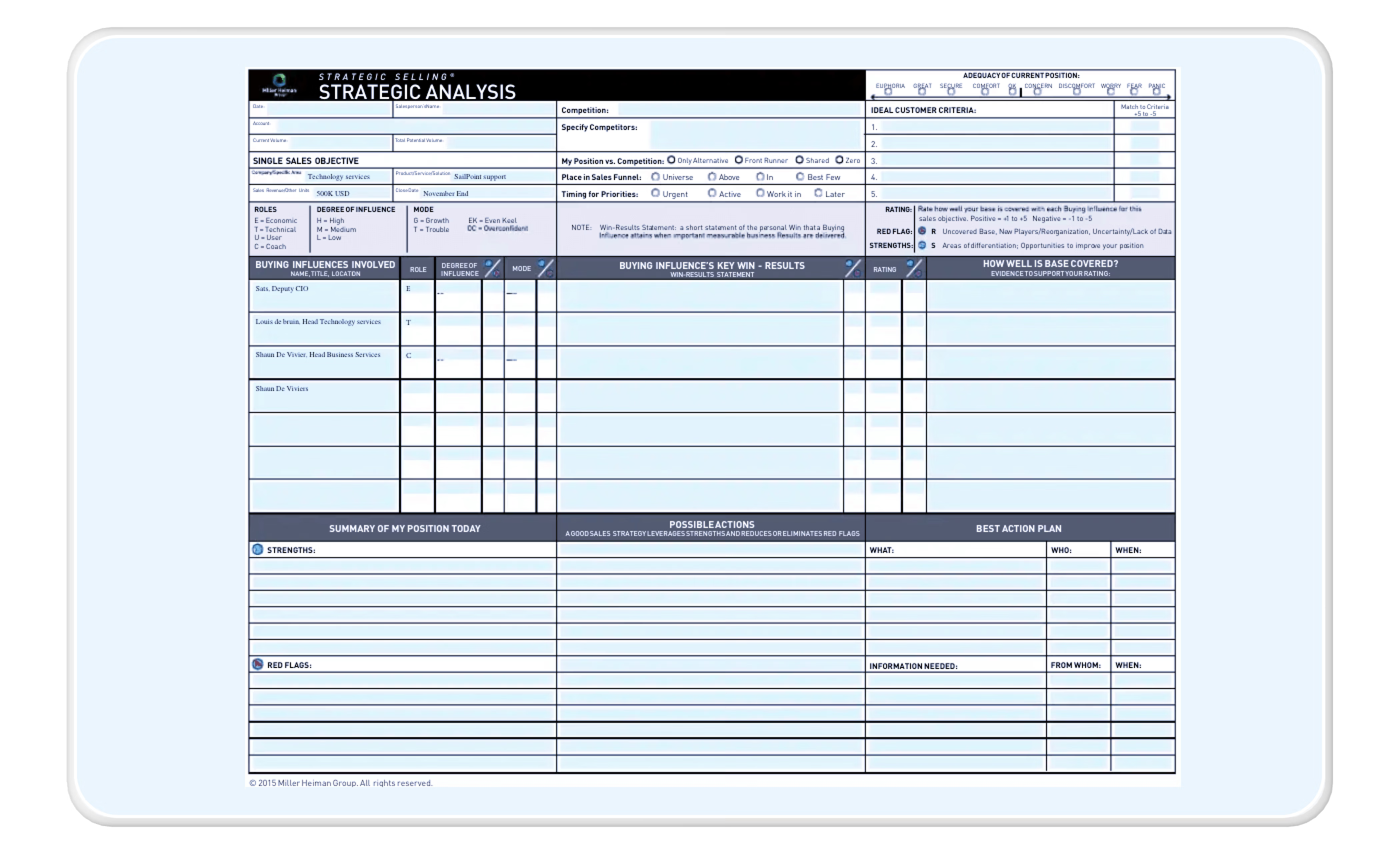
The Blue Sheet becomes a living document updated throughout 30 to 90-day enterprise sales cycles. This continuous intelligence gathering, tracked in CRM platforms like HubSpot, Salesforce, Pipedrive, and Zoho CRM, helps reps close sales deals by building relationships across all stakeholder groups rather than relying on a single champion.
Pros and cons of the Miller Heiman sales process
Before implementing Miller Heiman Strategic Selling, sales leaders at mid-market and enterprise B2B companies should evaluate whether this methodology aligns with their sales complexity, team capabilities, and deal cycles.
Here's an evaluation to guide your decision:
Pros
- Structured framework: Miller Heiman provides repeatable Blue Sheet and Green Sheet tools that guide sales teams through complex enterprise deals at companies like IBM, Oracle, and Cisco Systems, ensuring no critical stakeholder or evaluation criterion is overlooked during 60 to 180 day sales cycles.
- Stakeholder alignment: The methodology's focus on identifying and addressing each buying influence's specific needs—Economic Buyers see ROI, Technical Buyers evaluate security, User Buyers assess workflow fit—creates mutually beneficial outcomes where all parties achieve measurable value.
- Proven track record: Used by Fortune 500 companies since 1985, Miller Heiman has trained over 1 million sales professionals worldwide and integrates seamlessly with modern CRM platforms.
Cons
- Time investment: Initial Blue Sheet completion requires three to five hours for comprehensive stakeholder mapping and strategic analysis, with new reps needing 90-120 days to achieve proficiency in the methodology.
- Complexity barrier: The framework's eight Blue Sheet components (single sales objective, buying influences, influence modes, strengths/red flags, win results, ideal customer criteria, action plan, unknowns) can overwhelm sales teams accustomed to simpler qualification methods like BANT.
- Limited applicability: Best suited for complex B2B sales with multiple stakeholders and deals exceeding $50,000; transactional sales, SMB markets, or single-decision-maker purchases benefit more from streamlined approaches.
Organizations selling complex solutions with multiple buying influences and extended sales cycles—such as enterprise SaaS platforms, manufacturing equipment, or financial services—typically benefit most from the structured Blue Sheet approach.
On the other hand, companies with transactional sales or single-stakeholder decisions often find simpler methodologies like BANT (Budget, Authority, Need, Timeline) or SPIN Selling more appropriate for their sales environment.
Miller Heiman strategic framework: How does it work?

Grab your blue sheet
The Blue Sheet got its name in 1978 when Miller and Heiman's Reno, Nevada printer ran out of white paper while printing their strategic analysis worksheets. The forms came out on blue paper instead, and the distinctive color made them instantly recognizable to sales teams. When Miller and Heiman published "Strategic Selling" in 1985, the "Blue Sheet" had already become the unofficial name for their methodology's core planning document.
Today, electronic versions replace the physical blue worksheets, integrated directly into CRM platforms. Sales teams can integrate their Blue Sheet analysis directly into proposal creation using tools like Qwilr and build sales proposals that automatically update stakeholder information, pricing scenarios, and ROI calculations as buying influences change throughout the deal.
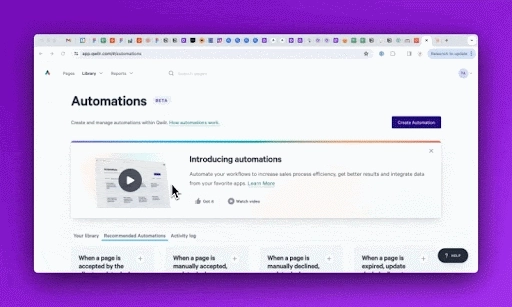
State your single sales objective
A single sales objective is Miller Heiman's requirement to define one specific, measurable goal for each deal that creates win-win value for both buyer and seller.
For example, an enterprise SaaS sales executive looking to close a deal with Coca-Cola might say their single sales objective is to sell $45 million worth of their software to Coca-Cola.
To support Miller Heiman's requirement for specific single sales objectives, tools like Qwilr enable sales reps to create interactive pricing tables where prospects can configure their exact solution (selecting user tiers, add-ons, and contract lengths).
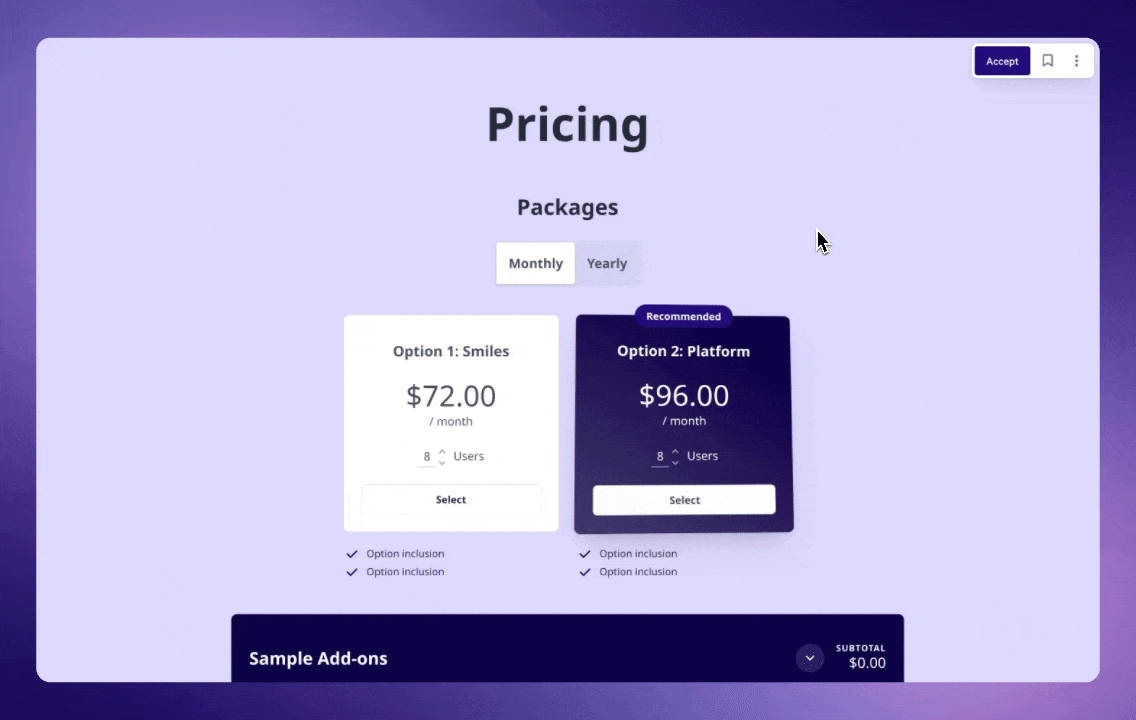
Map out your buying influences
In enterprise B2B sales at companies like Salesforce, Amazon Web Services, or Oracle, Miller Heiman's methodology identifies four buying influence types that sales teams must engage throughout the decision process. According to Gartner research, a complex sales environment typically involves six to ten stakeholders, each with distinct priorities and veto power over the final decision.
Miller Heiman categorizes buying influences into the following:
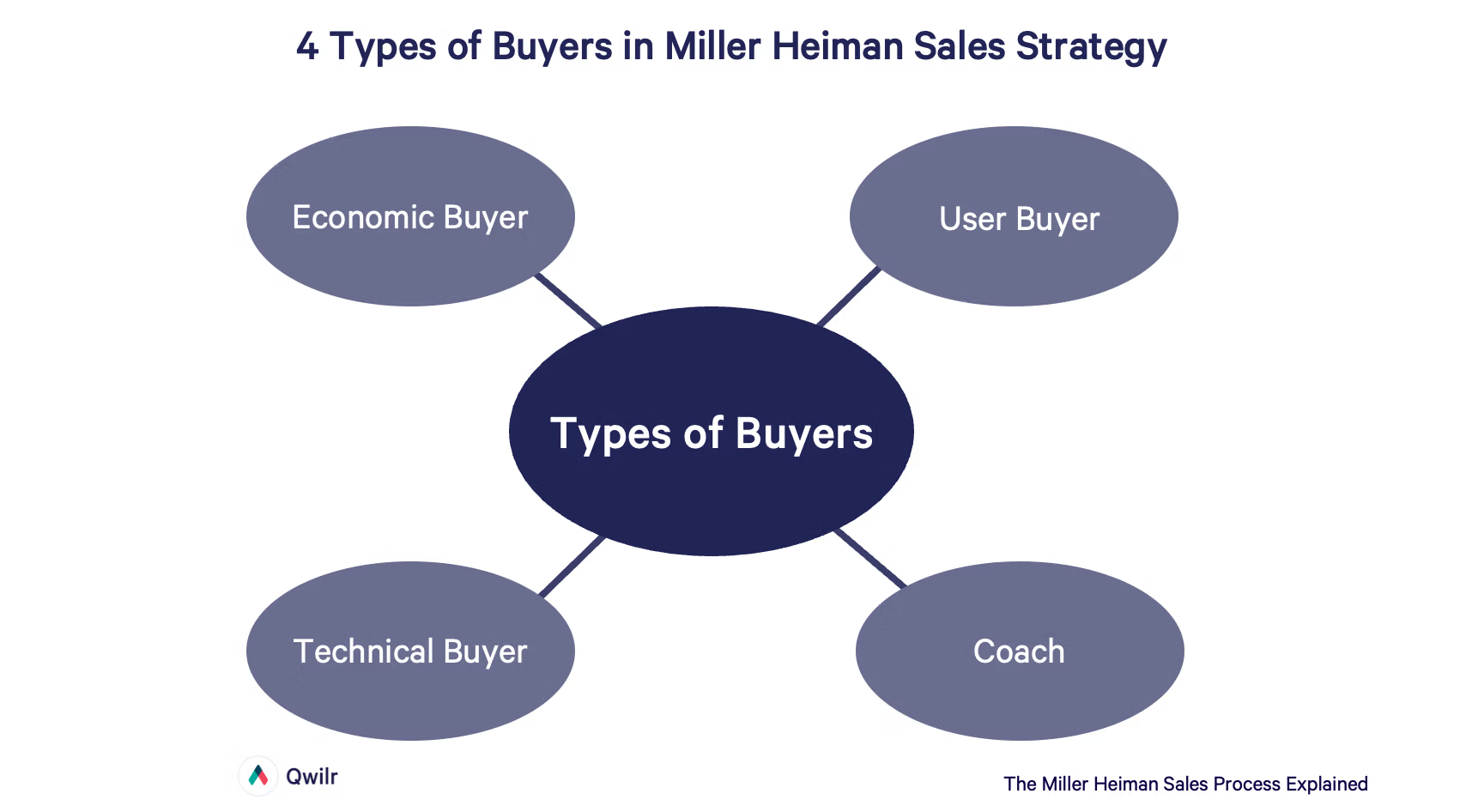
Economic Buyer: The final decision authority who controls budget approval. This person can override all other stakeholders—saying yes when everyone else says no, or vice versa. Typically a CFO, VP, or department head at director level or above.
- User Buyer: The daily user of your solution. In enterprise accounts, you may encounter multiple user buyers across different teams or departments.
- Technical Buyer: Evaluates whether your solution meets technical, security, and integration requirements. Often a CIO, IT Director, or Security Officer who doesn't work in the department buying your solution but assesses compliance, data protection, and system compatibility.
- Coach: Your internal advocate who actively supports only your solution. A true Coach has organizational influence to provide access to decision-makers and strategic intelligence. Without this access, they're a brand supporter, not a strategic Coach.
Pro tip: When managing multiple buying influences, sales teams use Qwilr's content blocks to create proposals with stakeholder-specific sections.
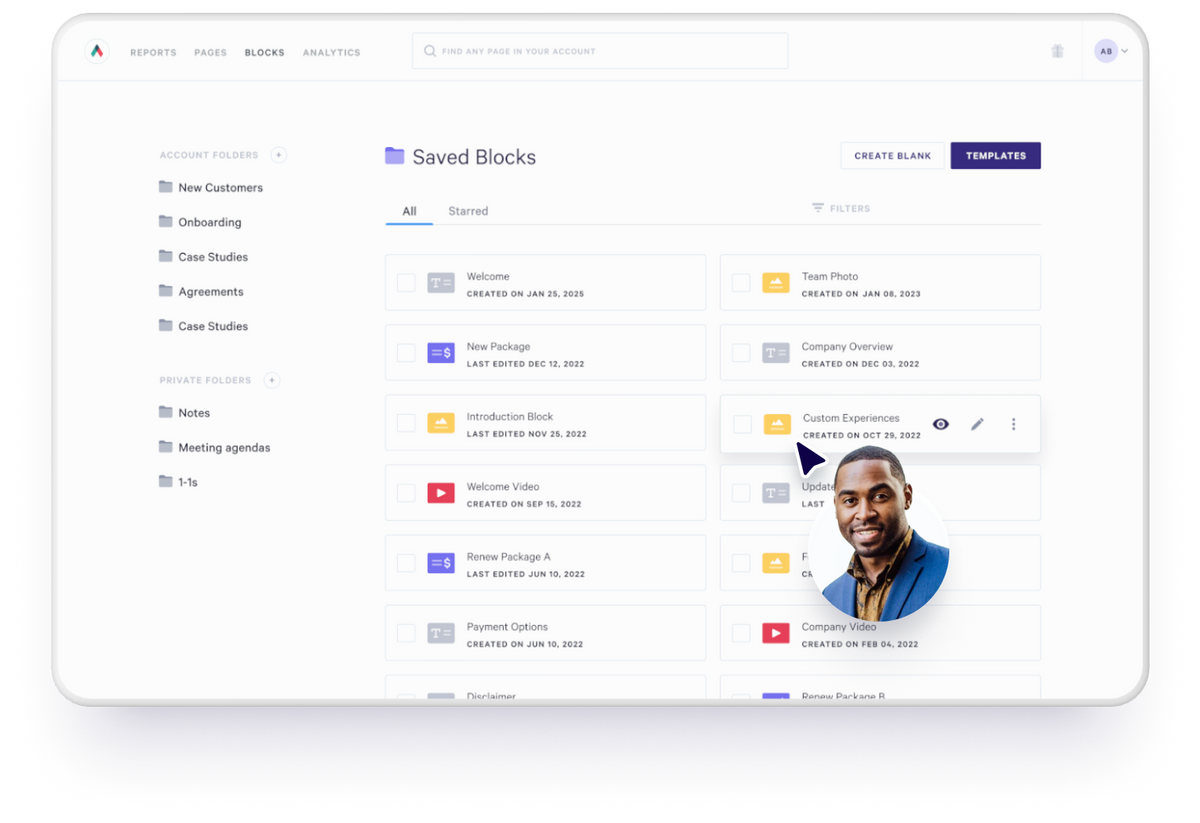
You can pre-save these blocks to speed up proposal creation.
Miller Heiman also categorizes how each stakeholder views change:
- Growth Mode: Ready to abandon the status quo to accelerate organizational growth. Actively seeking new solutions.
- Trouble Mode: Facing an urgent, significant problem requiring immediate solution to avoid larger consequences.
- Even Keel: Not actively seeking change. May engage but has no urgency to purchase unless shown compelling ROI.
- Overconfident: Committed to current solution, often having selected it themselves. Resistant to alternatives even when required to attend evaluation meetings.
Consider your strengths and red flags
The Blue Sheet requires sales teams to document both competitive advantages and potential deal risks before engaging stakeholders. This analysis includes product differentiators, alignment with customer requirements, and weaknesses that could derail the sale.
For example, a sales rep selling financial modeling software like Planful to mid-market companies might list scalability as a strength—the platform grows from 50-employee startups to 500-employee enterprises. But a red flag might be that the pricing model requires a minimum finance team of five people, making it unviable for companies with smaller finance departments using tools like QuickBooks or Xero.
When completing this analysis, map your solution's strengths against each buying influence's specific pain points. For example, a User Buyer (the financial analyst team) might need Excel integration and reporting automation. A Technical Buyer (the IT Director)
Buyer enablement tools like Qwilr allow sales teams to create interactive ROI calculators within proposals, letting Economic Buyers input their current costs and instantly see projected savings.

Instead of abstract value propositions, sales teams can present concrete win results tailored to their specific situation.
Create your win results statement
Win results statements answer one critical question for each buying influence: "How will this person win when my product delivers on its promises?"
Miller Heiman's philosophy centers on mutually beneficial outcomes. A true win-win means both the sales organization and every stakeholder achieve measurable value. If deep discounting is the only path to closing, the deal lacks genuine mutual benefit.
Effective win results statements are specific and stakeholder-focused:
- Economic Buyer (CFO): "Reduces financial close process from 15 days to 6 days, enabling faster board reporting and quarterly earnings announcements—a priority mentioned in Q3 earnings call."
- User Buyer (Financial Analyst): "Eliminates 20 hours monthly of manual Excel consolidation, allowing the team to focus on strategic analysis rather than data aggregation."
- Technical Buyer (IT Director): "Achieves SOC 2 Type II compliance required for enterprise customer contracts, removing a current blocker for the sales team."
- Coach (VP of Finance): "Delivers the reporting automation capability leadership requested, positioning them as the executive who modernized the finance function."
Creating win results statements for deals requires understanding individual stakeholder KPIs, quarterly objectives, and personal career advancement metrics.
List your ideal customer criteria and score yourself
The Blue Sheet methodology requires sales teams to define ideal customer profile (ICP) criteria and honestly assess how well their solution meets those standards. This self-evaluation, ideally completed with your Coach's input, reveals where you have competitive advantages and where you'll need to proactively address objections.
Sample ICP criteria for enterprise SaaS:
- Company size: 500-5,000 employees
- Technology stack: Uses Salesforce, Microsoft Azure, or AWS
- Budget authority: $250K-$2M annual software spend
- Current pain: Manual processes consuming 15+ hours weekly per team member
- Decision timeline: 60-90 day evaluation and implementation window
- Technical requirements: API access, SSO via Okta or Azure AD, SOC 2 compliance
Score your solution on each criterion using Miller Heiman's framework: Strong Match (competitive advantage), Acceptable Match (meets requirements), or Gap (requires mitigation strategy).
For example, if selling marketing automation software like HubSpot to a company currently using Mailchimp, you might score:
- Integration capabilities: Strong Match (native Salesforce integration vs. competitor's limited API)
- Ease of use: Acceptable Match (steeper learning curve but more powerful features)
- Price point: Gap (3x current spend—requires ROI justification with concrete metrics)
This honest assessment prevents surprises late in the sales cycle and allows you to build mitigation strategies early.
This rigorous self-evaluation mirrors how investors assess opportunities. The same discipline around honest assessment versus overpromising is explored in this guide to credible proposals:
Create your plan of action
Miller Heiman mandates a documented action plan as part of the Blue Sheet process. This plan maps specific activities, touchpoints, and information-gathering objectives across all buying influences throughout the sales cycle.
A comprehensive action plan for enterprise deals at companies like IBM, Microsoft, or Cisco typically includes:
Discovery phase (Weeks 1-3)
- Sales meetings with Coach and User Buyers to understand current workflows
- Technical deep-dive with IT/Security team to document integration requirements
- Economic Buyer introduction to establish budget authority and decision timeline
Evaluation phase (Weeks 4-8):
- Product demonstrations tailored to each buying influence (User Buyers see daily workflows, Technical Buyers see security architecture, Economic Buyers see ROI models)
- Reference calls connecting prospect User Buyers with similar customers at comparable companies
- Competitive analysis addressing alternatives like Competitor A, Competitor B, or in-house options
Negotiation phase (Weeks 9-12):
- Pricing discussions with the Economic Buyer, including multi-year scenarios
- Contract review with Legal and Procurement teams
- Implementation planning with the Technical Buyer and operations teams
Your action plan should specify who needs to be involved at each stage, what information you need to gather, and how you'll address identified red flags. Sales teams using CRM platforms like Pipedrive can automate reminders for follow-up activities and track completion of each action item.
Seek out any additional information you need
After completing your initial Blue Sheet and action plan, Miller Heiman's methodology requires identifying information gaps before proceeding. This might include:
- Missing buying influences you haven't identified
- Unknown budget approval processes or fiscal year timing
- Unclear technical requirements or integration dependencies
- Competitive intel on alternatives being evaluated alongside your solution
Work with your Coach to gather this intelligence, or schedule targeted sales conversations with specific buying influences. For complex deals at Fortune 500 companies, sales teams often discover two to three previously unknown stakeholders during this phase—procurement specialists, compliance officers, or executive sponsors who must approve major purchases.
Sales managers play a critical sales enablement role here to help reps strategize approaches to reach senior stakeholders, navigate organizational politics, and determine whether to continue pursuing the opportunity or disqualify based on emerging red flags.
Continue to update your plan until your deal is done
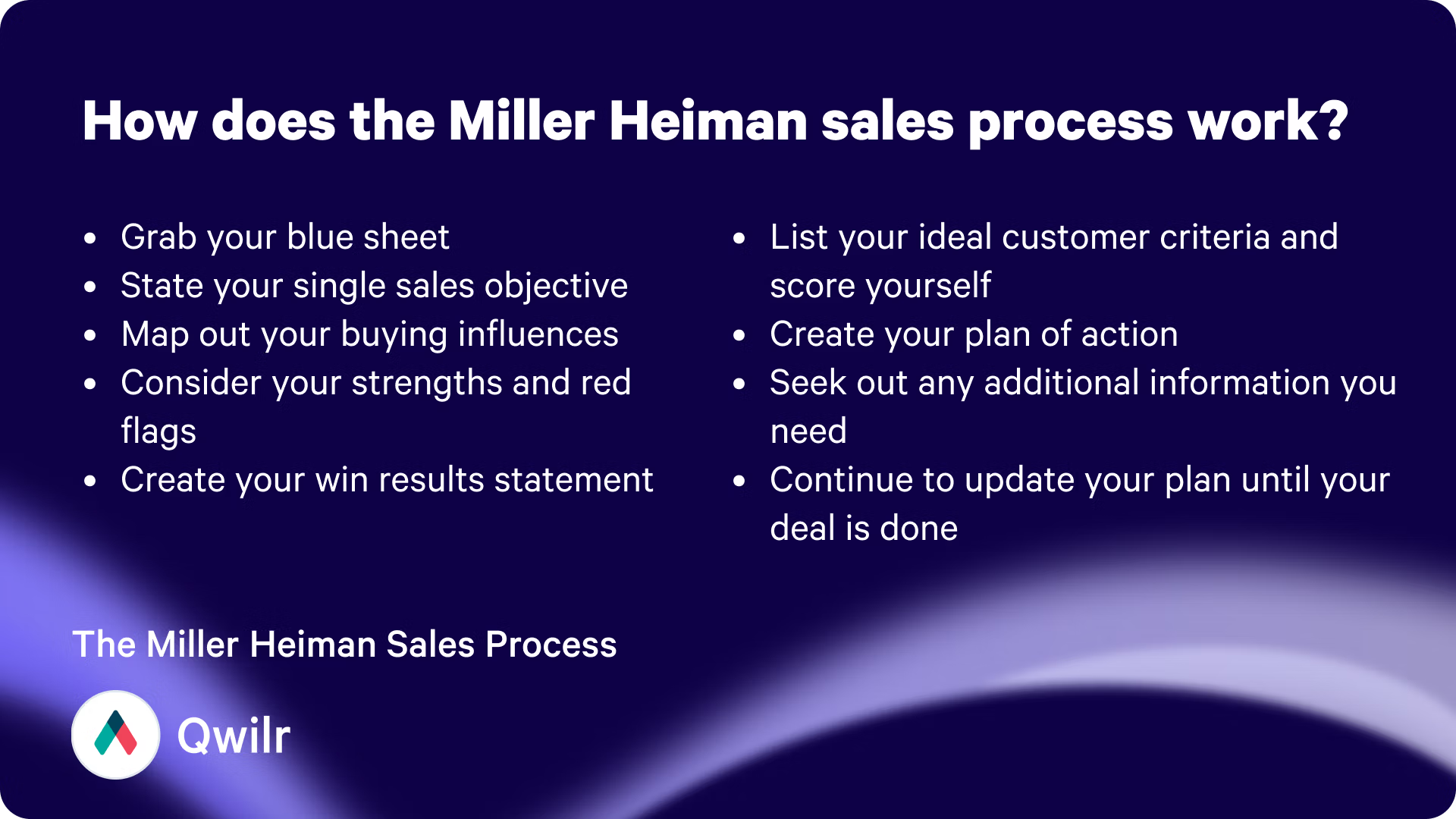
The Blue Sheet is a living document throughout 60 to 180-day enterprise sales cycles. As deals progress from discovery through negotiation at companies, sales teams ideally update their Blue Sheets 10 to 15 times as new information emerges.
Common updates include:
- New buying influences entering the process (a VP you didn't know existed)
- Shifting influence levels (the original Economic Buyer delegates authority to a different executive)
- Changed buying influence modes (an Even Keel stakeholder moves to Growth Mode after a competitor's service failure)
- Discovered strengths or red flags (learning your solution integrates with a critical tool the Technical Buyer requires)
- Competitive positioning changes (a new competitor enters the evaluation)
Unlike static PDF proposals, Qwilr's real-time analytics show which buying influences are engaging with your proposal, which sections they're spending time on, and when new stakeholders are added to the review process.

Sales reps can then update their Blue Sheet's buying influence map as the deal progresses and ensure the Coach is informed when the Economic Buyer finally opens the pricing section.
Top 5 benefits of the Miller Heiman sales strategy
1. Brings structure to the sales process
One of the biggest advantages of the Miller Heiman strategy is that it brings a structured, repeatable process to sales. Instead of relying on intuition or winging it, sales teams can follow a clear framework that guides them through each step of the sales cycle. Tools like the Blue Sheet and Green Sheet help organize everything, from mapping out the key decision-makers to strategizing your next move. This level of structure ensures that no critical step is overlooked, which can be a game-changer when managing complex, high-value sales.
2. Helps manage stakeholders effectively
In many sales situations—especially in B2B deals—you’re not just selling to one person; you’re dealing with multiple stakeholders with different roles and priorities. The Miller Heiman methodology makes it easier to identify and understand each person’s influence in the buying process, whether they’re a decision-maker, an influencer, or a potential blocker. By tailoring your approach to each individual, you can address their unique concerns and build alignment across the buying team, significantly increasing your chances of closing the deal.
3. Increases chances of closing deals
This strategy encourages sales professionals to think critically about their opportunities. Instead of chasing every potential lead, you’re guided to focus on deals where you’re most likely to succeed. By evaluating factors like the strength of your relationships with stakeholders and how well your solution aligns with the customer’s needs, you can prioritize the deals that are worth your time. This focus on quality over quantity not only saves time but also improves your overall win rates.
4. Keeps focus on customer needs
At its core, the Miller Heiman strategy is all about the customer. It encourages sales reps to really listen and understand what the buyer needs, rather than just pushing a product or service. The Conceptual Selling component of the methodology is particularly helpful here, as it emphasizes having meaningful conversations that uncover what’s most important to the buyer. When customers feel understood and see that you’re offering a solution tailored to their challenges, trust is built—and trust often leads to a yes.
5. Builds stronger long-term relationship
This strategy isn’t about making a quick sale and moving on; it’s designed to help you build lasting relationships. By focusing on your customer’s long-term goals and aligning your solutions to those goals, you position yourself as a partner rather than just a vendor. This approach not only helps you close the immediate deal but also lays the groundwork for future opportunities, repeat business, and even referrals. It’s a win-win for both the seller and the buyer.
Implementing Miller Heiman with modern sales tools
While Blue Sheets traditionally lived in spreadsheets or CRM custom fields, modern sales teams combine strategic analysis with buyer-facing materials. Qwilr offers Miller Heiman-specific proposal templates that structure content around the four buying influences, all trackable to see which stakeholders engage with which content.
Want to see how this works in practice? Explore the templates or start a free Qwilr trial.
About the author

Kiran Shahid|Content Marketing Strategist
Kiran is a content marketing strategist with over nine years of experience creating research-driven content for B2B SaaS companies like HubSpot, Sprout Social, and Zapier. Her expertise in SEO, in-depth research, and data analysis allow her to create thought leadership for topics like AI, sales, productivity, content marketing, and ecommerce. When not writing, you can find her trying new foods and booking her next travel adventure."
FAQs
Robert B. Miller and Stephen E. Heiman developed the Miller Heiman Strategic Selling methodology between 1978 and 1985 while consulting for Fortune 500 companies including IBM, Xerox, and Hewlett-Packard. They founded Miller Heiman & Associates in Reno, Nevada, in 1978 and published their bestselling book "Strategic Selling" in 1985, which has trained over 1 million sales professionals worldwide.
The Blue Sheet's ideal customer criteria section requires sales teams to identify specific requirements their prospect uses to evaluate solutions—such as technical capabilities, pricing, implementation timeline, vendor stability, and integration with existing systems like Salesforce or Microsoft Dynamics 365. Sellers then rate their solution's match to each criterion on a -5 to +5 scale, with negative scores indicating gaps requiring mitigation strategies.
Full Miller Heiman implementation at enterprise sales organizations typically requires 3-6 months, including 2-3 days of initial training through Korn Ferry, 30-60 days for CRM integration with platforms like Salesforce or HubSpot, and 90-120 days for team adoption. Sales teams usually complete their first Blue Sheets within 30 days of training and see measurable improvements in forecast accuracy and stakeholder engagement within the first quarter.
